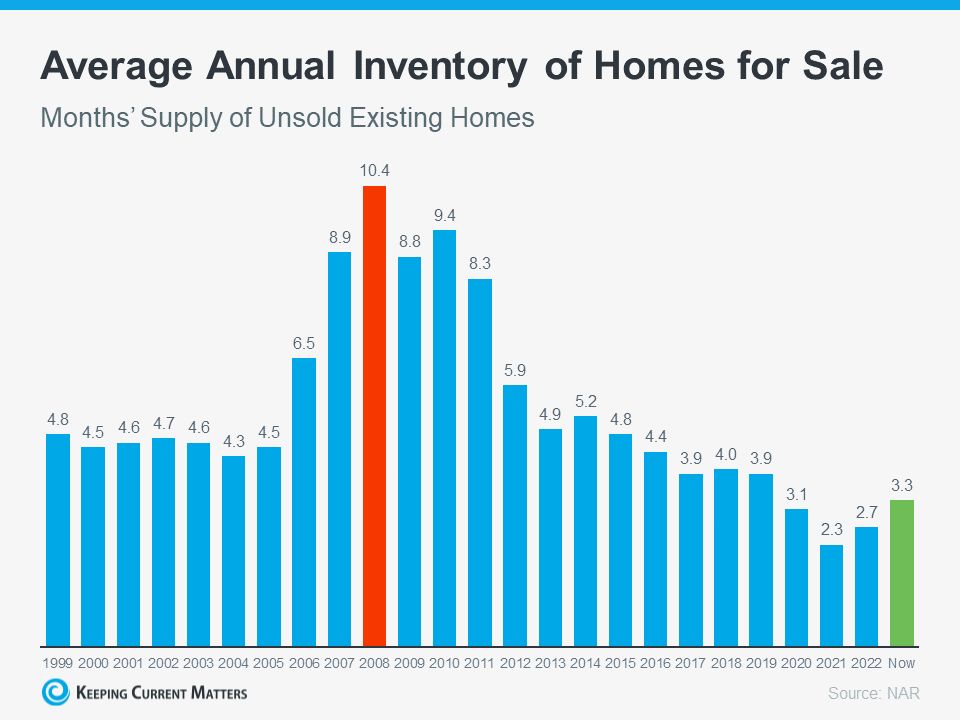Low housing Inventory Suggests That a Crash is Unlikely

You may recall the housing market downturn of 2008, even if you weren't a homeowner then. If you're concerned about the possibility of a similar scenario repeating itself, there's reassuring information: the current housing market differs significantly from that of 2008.
One key reason why a housing market crash is unlikely is that there are not enough homes for sale. This is called undersupply, and it is the opposite of oversupply, which was a major factor in the 2008 crash. For the housing market to crash, there would need to be too many homes for sale, but the data does not show that happening.
The three main sources of housing supply are:
- Homeowners putting their homes on the market
- New construction homes
- Homes under foreclosure or short sale
Let's examine today's housing inventory more closely to understand why the market is different from 2008.
Homeowners Deciding To Sell Their Houses
While there has been some growth in housing supply compared to the previous year, it remains at a relatively low level. The current months' supply is below the typical range, as illustrated in the graph below. If we compare the most recent data (depicted in green) to the figures from 2008 (represented in red), it becomes apparent that today's available inventory is only about one-third of what was available back then.

So, what does this mean? There are simply not enough homes available for sale to cause home values to drop. To have a repeat of 2008, there would need to be many more people selling their homes with very few buyers, and that is not happening right now.
Newly Built Homes
There is also a lot of discussion about new construction homes today, and you may be wondering if homebuilders are building too many. The graph below shows the number of new houses built over the last 52 years:

The 14 years of underbuilding (shown in red) is a major reason why housing inventory is so low today. In other words, builders have not been building enough homes for years, and this has created a significant supply shortage.
While the final blue bar on the graph shows that home construction is increasing and is on track to reach the long-term average again, this will not suddenly create an oversupply of homes. This is because there is a large shortfall in supply to make up. Additionally, builders are being careful not to overbuild homes like they did during the housing bubble.
Distressed Properties (Foreclosures and Short Sales)
The final source of housing inventory is distressed properties, such as short sales and foreclosures. During the housing crisis, there was a surge in foreclosures due to lending standards that allowed many people to obtain mortgages that they could not truly afford.
Today, lending standards are much stricter, resulting in more qualified borrowers and significantly fewer foreclosures. The graph below uses data from the Federal Reserve to show how things have changed since the housing crash:

This graph shows how the number of foreclosures has decreased as lending standards have become stricter and borrowers have become more qualified. In 2020 and 2021, a moratorium on foreclosures and the forbearance program helped to prevent a repeat of the wave of foreclosures that we saw in 2008.
The forbearance program was a game-changer, giving homeowners options for loan deferrals and modifications that they did not have before. Data shows that four out of five homeowners who exited the forbearance program are either fully paid up or have a repayment plan in place to avoid foreclosure. These are some of the biggest reasons why there is unlikely to be a wave of foreclosures hitting the market.
What This Means for You
Housing inventory levels are nowhere near where they would need to be for prices to drop significantly and the market to crash. According to Bankrate, this is unlikely to change anytime soon, especially given the continued strong demand from buyers.
“The ongoing lack of housing inventory explains why many buyers still have few options but to bid up prices. This also suggests that the supply-and-demand equation for housing simply will not allow for a price crash in the near future.”
Bottom Line
The housing market does not have enough available homes for a repeat of the 2008 housing crisis, and there is no indication that this will change anytime soon. Therefore, housing inventory shows that there is no crash on the horizon.
Categories
Recent Posts










GET MORE INFORMATION


